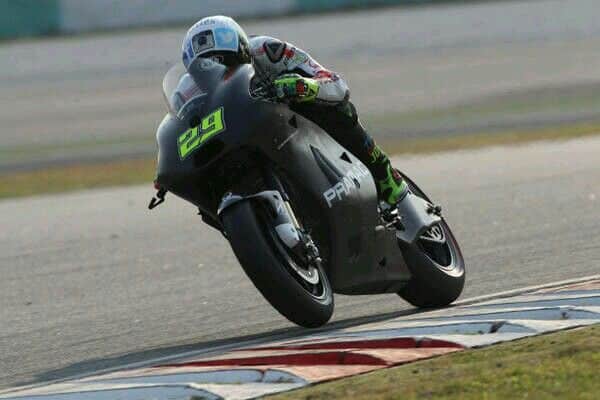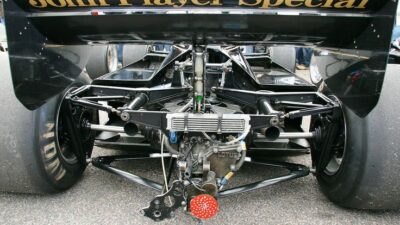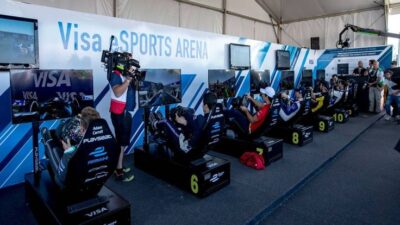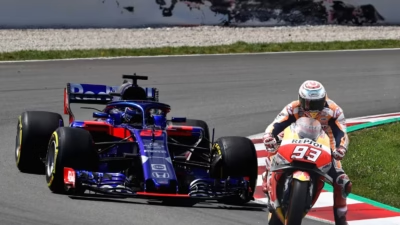MotoGP riders face one of the most challenging moments in racing when the lights go out at the start of a race. With over 260 horsepower at their disposal, getting off the line cleanly requires precise control and advanced technology working together.

Launch control is a rider-aid system designed to help MotoGP riders maximize acceleration when they release the clutch at race starts. The system prevents dangerous wheelies and helps riders manage the massive torque delivery that could otherwise send them into a loop or cause them to lose valuable positions at the critical race start.
The technology has evolved significantly since MotoGP introduced electronic aids. Modern launch control works alongside other systems like anti-wheelie controls and holeshot devices that lower the bike’s center of gravity for better grip and stability. Understanding how these systems function reveals the complex balance between rider skill and electronic assistance that defines modern Grand Prix racing.
Key Takeaways
- Launch control helps riders manage 260+ horsepower at race starts by preventing dangerous wheelies and controlling power delivery
- The system works with holeshot devices and anti-wheelie controls to optimize traction and bike stability during acceleration
- Modern MotoGP uses unified software that requires more rider skill compared to the highly advanced factory systems used in earlier years
Fundamentals of Launch Control Systems in MotoGP
Launch control systems in MotoGP help riders manage massive power delivery during race starts, while Dorna’s unified software has simplified these systems compared to earlier factory versions. These electronic aids work alongside other technologies to optimize acceleration while maintaining safety standards.
Purpose and Evolution of Launch Control
Launch control exists because overtaking in MotoGP becomes increasingly difficult due to similar bike performance and advanced braking systems. The race start has become more critical than ever for competitive positioning.
Early factory systems allowed riders to use full throttle and dump the clutch without consequences. The sophisticated electronics managed power delivery so precisely that riders could maintain control with the front wheel barely off the ground.
Dorna introduced unified software to reverse the technology’s purpose from performance enhancement back to safety improvement. Magneti Marelli developed this standardized system to reduce the complexity of earlier factory electronics.
The change forced riders to develop more skill-based techniques. Modern launch control requires riders to do most of the work themselves, rewarding talent over technology dependence.
Key Components and Technologies
Launch control operates through a button on the left handlebar that activates specific strategies for race starts. The system automatically deactivates when riders begin decelerating into the first corner.
Key technical features include:
- Rev limiter adjustment – allows full throttle without over-revving risk
- Anti-wheelie integration – reduces engine torque during gear changes
- Clutch engagement optimization – helps manage initial power delivery
- Gear-specific mapping – adjusts power through different gears
The system works with holeshot devices that compress suspension to lower the bike’s center of gravity. This mechanical setup improves traction and stability during acceleration.
Launch control settings vary for each race based on track conditions, weather, tire choice, and rider feedback. Engineers adjust parameters until the last moment before races.
How Launch Control Differs from Other Rider Aids
Launch control specifically excludes traction control functionality, unlike other rider aids. The system only operates anti-wheelie features because fewer control strategies working simultaneously produces better results.
Riders often experience wheelspin during starts despite launch control activation. This happens because the system focuses on preventing dangerous wheelies rather than eliminating all wheel slip.
Launch control vs other aids:
| System | Primary Function | Active Duration |
|---|---|---|
| Launch Control | Start optimization | Race start only |
| Traction Control | Wheel slip prevention | Throughout race |
| Anti-wheelie | Front wheel management | All acceleration |
MotoGP riders can adjust anti-wheelie and launch control maps using blue buttons on their handlebars. These systems recognize when the front tire leaves the track surface using gyroscopic sensors.
The simplified approach means straight-line wheelspin becomes the rider’s responsibility to control through throttle management rather than electronic intervention.
Mechanics of a MotoGP Race Start
The start of a MotoGP race involves precise coordination between electronic systems, rider inputs, and mechanical components. Launch control systems help riders manage 260 horsepower while clutch technique and rider confidence determine race position after the first corner.
Role of Launch Control at the Starting Grid
Launch control activates when riders press a button on their left handlebar before the race begins. The system automatically switches off when riders start braking for the first corner.
Key Functions:
- Adjusts rev limiter for safe full-throttle operation
- Controls anti-wheelie systems during acceleration
- Does not include traction control features
The unified software limits power delivery compared to factory systems used before 2016. Modern launch control focuses on safety rather than maximum performance.
Riders can no longer dump the clutch at full throttle like they could with factory electronics. The current system requires more rider input and skill to achieve optimal starts.
Electronic systems recognize when the front tire leaves the track surface using gyroscopes. This data helps control wheelie behavior during the launch phase.
Clutch and Throttle Management
Modern MotoGP starts require careful clutch and throttle coordination. Riders typically begin with 75% throttle rather than full power to manage initial torque delivery.
Starting Technique:
- Partial throttle at clutch release
- Gradual increase to full power
- Secondary clutch modulation during acceleration
Bradley Smith explains that riders must use the clutch again when going to full power. Without proper technique, the anti-wheelie system creates a bouncing effect.
Throttle response becomes critical during gear changes. The system reduces engine torque delivery each time riders shift from first to second, third, and fourth gears.
Many riders experience wheelspin throughout the acceleration phase. This happens because launch control only operates anti-wheelie systems, not traction control.
Influence of Rider Skill and Confidence
Race starts now reward rider ability more than electronic assistance. The reduction in factory software effectiveness means riders must develop better clutch control and throttle management skills.
Skill Requirements:
- Clutch timing: Precise release and modulation
- Throttle control: Progressive power application
- Body positioning: Managing weight transfer
Rider confidence affects starting performance significantly. Nervous riders tend to blip the throttle before the lights go out, though this serves no practical purpose.
Riders had to retrain themselves after the unified software introduction. Some experienced complete sideways slides during early races as they adapted.
Power wheelies now indicate rider control rather than electronic management. When riders see the front wheel lift, they must manage it through throttle input rather than relying on software intervention.
Integration with Electronic Systems
Launch control operates through sophisticated electronic integration that connects engine management with real-time sensor data. The system relies on unified software platforms and precision wheel speed monitoring to deliver consistent performance across all MotoGP teams.
Engine Control Unit (ECU) and Unified Software
The Magneti Marelli ECU serves as the central hub for all MotoGP electronic systems. This standardized unit processes launch control commands alongside other rider aids like traction control and anti-wheelie functions.
MotoGP’s unified software platform significantly changed how teams approach launch control. The system replaced manufacturer-specific programs with standardized code in 2016.
Key ECU functions include:
- Processing throttle input signals
- Managing rev limiter adjustments
- Coordinating anti-wheelie intervention
- Switching between launch and normal riding modes
The ECU automatically deactivates launch control when riders begin braking for the first corner. This seamless transition prevents interference with normal racing electronics.
Teams can adjust launch control parameters within the unified software’s limits. However, the standardized approach reduces the extreme performance advantages that factory-specific systems once provided.
Wheel Speed Sensors and Data Analytics
Wheel speed sensors provide critical telemetry data that enables launch control functionality. These sensors monitor front and rear wheel speeds independently to detect wheelies and wheelspin events.
The sensors transmit data at extremely high frequencies during race starts. Engineers analyze this information to understand how effectively the launch control system manages power delivery.
Primary sensor measurements:
- Front wheel speed variations during wheelies
- Rear wheel speed indicating wheelspin levels
- Comparative analysis between wheel speeds
- Real-time feedback for system adjustments
Data analytics reveal specific performance patterns during launch sequences. Teams use this telemetry to optimize launch control settings for different track conditions.
The wheel speed sensors help distinguish between controlled wheelspin and dangerous wheel slip. This data allows the system to permit manageable rear wheel spin while preventing excessive front wheel lift through anti-wheelie intervention.
Anti-Wheelie and Traction Control Functions
Launch control systems in MotoGP work with anti-wheelie technology to prevent dangerous front wheel lift during starts, while traction control manages rear wheel grip separately. These systems control wheelspin through throttle modulation and torque delivery adjustments during acceleration phases.
Anti-Wheelie Technology in Race Starts
Anti-wheelie systems prevent uncontrolled wheelies during race starts by monitoring front wheel speed and reducing engine torque when needed. The technology keeps the front wheel only inches off the ground during maximum acceleration.
When riders shift gears during starts, the anti-wheelie drastically reduces engine torque delivery to minimize wheelies at each gear change. This happens automatically as riders move through second, third, and fourth gears.
Key Anti-Wheelie Functions:
- Monitors front and rear wheel speeds
- Reduces torque when front wheel lifts
- Activates during gear shifts
- Works independently from traction control
The system allows riders to focus on clutch control and throttle application without worrying about dangerous rear-end flips.
Interaction with Traction and Grip
Launch control operates anti-wheelie functions but does not operate the traction control system during race starts. This separation means riders can experience wheelspin while anti-wheelie remains active.
Traction control and anti-wheelie work as separate systems during launches. Anti-wheelie focuses on preventing front wheel lift while traction control would manage rear wheel grip if activated.
Modern MotoGP electronics include both systems among the five main rider aids: traction control, anti-wheelie, engine-braking control, anti-jerk, and launch control itself.
The reduced integration means riders must manually control more aspects of the launch compared to previous factory electronics systems.
Managing Wheelspin and Acceleration
Wheelspin occurs regularly during MotoGP race starts despite launch control systems being active. Straight-line wheelspin is not considered dangerous for MotoGP riders who can control it with throttle input.
Launch control adjusts the rev limiter so riders can open the throttle fully without over-revving. This allows focus on throttle and clutch balance rather than engine protection.
Wheelspin Management:
- Red trace above white trace indicates wheelspin on telemetry
- Spikes occur at each gear shift
- Continues until rider slows for first corner
- Controlled by rider throttle input
Riders like Bradley Smith had to retrain their technique when unified software replaced factory electronics. They now start with reduced throttle percentage rather than full power to manage initial torque engagement better.
Holeshot Devices and Physical Launch Aids
Holeshot devices work by lowering the motorcycle’s center of gravity and preventing wheelies during acceleration. These mechanical systems adjust suspension height to maximize power transfer to the ground at race starts.
Front and Rear Suspension Adjustments
The MotoGP holeshot device was first introduced by Ducati in 2019 on their GP19 motorcycle. The system affects the rear suspension to reduce ground clearance and increase traction.
Riders manually activate the device using controls near the handlebars before race starts. The mechanism lowers the rear of the bike, making it look like a dragster with a completely dropped rear end.
Rear holeshot devices remain legal and widely used across all teams. Every manufacturer on the current MotoGP grid has adopted this technology since Ducati’s introduction.
Front holeshot devices were banned starting in 2023. Ducati introduced a front wheel lowering system at the end of 2022, but regulations quickly prohibited any device affecting front wheel height.
New MotoGP regulations will ban all holeshot devices in 2027 to reduce costs and increase competitiveness.
Weight Distribution for Optimal Starts
The best way to improve MotoGP acceleration isn’t adding horsepower but reducing front-wheel lift. Lowering the center of gravity keeps more weight over the rear wheel during launches.
The lowered position creates a more compact motorcycle profile. This stance reduces the bike’s tendency to wheelie when full power is applied from the starting grid.
Weight transfer benefits:
- Increased rear tire contact pressure
- Better traction during initial acceleration
- Reduced energy wasted lifting the front wheel
- More consistent power delivery to the ground
Teams can also use holeshot devices during races on straights and corner exits. The system helps unleash full engine power where acceleration is most important.
The device works by changing the motorcycle’s geometry rather than adding electronic controls. This mechanical approach fits within MotoGP’s restrictions on electronic prototype development.
Strategic Impact and Future Developments
Launch control systems have fundamentally changed how teams approach race strategy and rider development in MotoGP. These technologies continue to evolve rapidly, creating new safety considerations while pushing performance boundaries that extend far beyond the starting grid.
Influence on Race Strategy and Performance
Teams now build entire race strategies around launch control capabilities. Grid position matters more than ever because superior launch systems can deliver crucial advantages in the opening meters.
The sophisticated rider aids like launch control directly impact qualifying strategies. Teams prioritize front-row starts to maximize their launch control benefits.
Performance metrics show clear advantages:
- Better launch control can gain 0.2-0.5 seconds in the first 100 meters
- Reduced wheelie control translates to sustained acceleration advantages
- Corner exit performance improves through integrated ride-height systems
Race performance extends beyond starts. Modern launch systems work with ride-height devices that lower bikes during corner exits. This creates compound advantages throughout entire race distances.
Data analysis reveals that teams with superior launch technology often dictate early race pace. Other riders must adapt their strategies to compensate for launch disadvantages.
Safety, Regulations, and Rider Adaptation
Dorna implemented spec Magneti Marelli electronics in 2015 to control costs and level the playing field. This standardization improved rider safety by ensuring consistent system behavior across all bikes.
Key safety improvements include:
- Standardized wheelie control prevents dangerous front-end lift
- Consistent braking force management during race starts
- Reduced mechanical failures from overstressed components
Riders face increased cognitive demands from complex systems. Modern bikes require managing multiple electronic aids simultaneously during races.
The learning curve for new riders has steepened significantly. Teams invest heavily in simulator training to help riders master launch control timing and activation.
Braking forces interact directly with launch systems. Riders must coordinate launch control deactivation with first-corner braking to maintain optimal performance.
Recent Innovations and Future Trends
Ducati pioneered automated ride-height systems that work like hydraulic computers. These systems activate automatically when specific conditions are met during cornering.
Manufacturers focus on integrating launch control with cornering aids. Future systems will likely provide seamless transitions from launch to corner exit optimization.
Emerging development areas include:
- AI-powered launch optimization based on track conditions
- Integration with tire temperature monitoring
- Predictive systems that adjust launch parameters mid-race
The technology developed in MotoGP eventually reaches production motorcycles. Launch control systems already appear on high-end street bikes.
Future regulations may further restrict electronic aids to maintain competitive balance. Teams prepare for potential changes by developing mechanical solutions alongside electronic systems.
Advanced data analysis drives continuous improvement in launch control effectiveness. Teams use machine learning to optimize launch parameters for different track and weather conditions.
Frequently Asked Questions
Launch control systems in MotoGP involve complex electronic aids that manage power delivery during race starts. These systems operate under strict regulations and present both performance benefits and safety considerations for teams and riders.
How do launch control systems improve the performance of MotoGP bikes during the start?
Launch control helps riders manage the massive power of MotoGP bikes during race starts. The system allows riders to use maximum acceleration when they release the clutch on bikes with 260 horsepower.
The launch control system works with anti-wheelie technology to prevent the front wheel from lifting too high. This keeps the bike stable and maintains traction during the critical first seconds of a race.
Launch control also adjusts the rev limiter automatically. This means riders can open the throttle fully without worrying about over-revving the engine.
The system helps riders focus on throttle and clutch balance instead of managing multiple controls. This simplification allows for better reaction times when the starting lights go out.
What are the regulations regarding the use of launch control in MotoGP races?
MotoGP uses a unified software system provided by Dorna and Magneti Marelli. All teams must use this standardized launch control instead of creating their own custom systems.
The current regulations make launch control less effective than the factory systems used in early MotoGP years. This change was designed to improve safety rather than increase pure performance.
The unified software limits how much electronic assistance riders receive. Teams cannot modify the core launch control algorithms or create their own versions.
Launch control must deactivate automatically when riders begin braking for the first corner. The system cannot remain active throughout the race.
Can riders adjust launch control settings during a race, and if so, how?
Riders activate launch control by pressing a button on the left handlebar before the race start. The system switches off automatically when they start decelerating into the first corner.
During the race, riders can adjust anti-wheelie and launch control maps. They use blue buttons on their handlebars to change these electronic settings while riding.
The electronic systems recognize when the front tire leaves the track surface using gyroscopes. Riders can modify how aggressively the system reduces engine power in these situations.
Teams program different launch control strategies before each race. These settings account for track conditions, weather, tire choice, and suspension setup.
What is the technical mechanism behind launch control systems in high-performance motorcycles?
Launch control operates primarily through anti-wheelie technology rather than traction control. The system monitors wheel speeds and bike position using various sensors and gyroscopes.
When the front wheel lifts, the system reduces engine torque delivery to bring it back down. The anti-wheelie system drastically cuts torque each time riders change gears during acceleration.
The system works alongside holeshot devices that lower the bike’s center of gravity. Riders compress the suspension and activate the holeshot device to engage the suspension in a lowered position.
Launch control does not include traction control functions. Riders must manage rear wheel spin using their throttle control and riding skills.
How has the development of launch control systems impacted the strategies of MotoGP teams?
Teams now spend significant time developing launch control strategies for each specific race. Engineers analyze practice and qualifying data to optimize traction and power delivery for race starts.
Teams check settings until the last second before races, adjusting for weather conditions, track temperature, and tire choices. This requires constant communication between engineers and riders.
The unified software has reduced the competitive advantage that some manufacturers previously held. Teams must now focus more on mechanical setup and rider technique rather than electronic sophistication.
Launch control strategies vary significantly between different tracks and conditions. Teams develop multiple programs and select the most appropriate one based on real-time data.
Are there any safety concerns associated with the implementation of launch control in MotoGP motorcycles?
The old factory launch control systems created safety issues by making starts too effective. When all riders could launch perfectly, they arrived at the first corner simultaneously, increasing crash risk.
Current launch control systems require more rider skill and input. This reduces the likelihood of identical launch performance and spreads out the field slightly at race starts.
Riders still experience wheelspin and sliding during starts despite launch control. The system only manages wheelies, leaving traction control to the rider’s throttle management.
The transition from old factory systems to unified software initially caused problems. Some riders had to completely retrain their starting techniques, leading to sideways launches and loss of control during the adjustment period.










